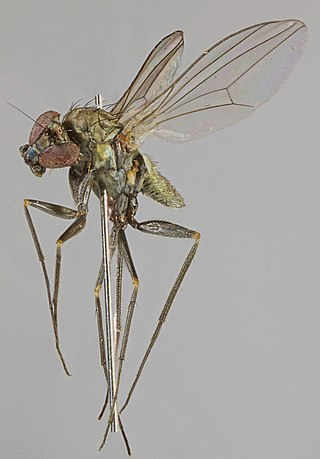
Argyra is a genus of flies in the family Dolichopodidae. The name "Argyra" comes from the Greek word for "silver".

Dolichopus is a large cosmopolitan genus of flies in the family Dolichopodidae. Adults are small flies, typically less than 8 mm in length. Nearly all species are metallic greenish-blue to greenish-bronze. It is the largest genus of Dolichopodidae with more than 600 species worldwide.

Medetera is a large genus of flies in the family Dolichopodidae. It includes about 350 species worldwide. The adults are commonly found resting on vertical surfaces such as tree trunks, on which they have a characteristic vertical upright stance. Because of this stance, they are sometimes known as "woodpecker flies". Medetera adults are predators of soft-bodied arthropods, while the larvae are predators of bark beetle larvae.
Micromorphus is a genus of flies in the family Dolichopodidae.
Nepalomyia is a genus of flies in the family Dolichopodidae.

Neurigona is a genus of flies in the family Dolichopodidae. It is a large genus, with over 150 known species.

Rhaphium is a genus of flies in the family Dolichopodidae. It is the largest genus within the subfamily Rhaphiinae, with over 200 species currently known.
Saccopheronta is a genus of flies in the family Dolichopodidae. It is considered a synonym of Medetera by some authors, and a valid genus by others.

Medeterinae is a subfamily of flies in the family Dolichopodidae.

Peloropeodinae is a subfamily of flies in the family Dolichopodidae. In some classifications, the genera of the subfamily are included in Sympycninae. According to Germann et al. (2011), the subfamily is polyphyletic.

Dolichopus lepidus is a species of fly in the family Dolichopodidae. It is found in the Palearctic.

Medetera truncorum is a species of fly in the family Dolichopodidae. It is widely distributed in the Western Palaearctic. It also occurs in the Pacific Northwest in North America, where it may be an introduced species.

Syntormon pallipes is a species of fly in the family Dolichopodidae. It is found in the Palearctic, Oriental and Afrotropical realms. In 2019, the mitochondrial genome of S. pallipes was sequenced, as the first representative of the subfamily Sympycninae.

Sciapus platypterus is a species of fly in the family Dolichopodidae. It is found in the Palearctic.

Parathalassiinae is a subfamily of flies in the family Dolichopodidae. It is part of an extended concept of the family, Dolichopodidae sensu lato, and forms a monophyletic group with Dolichopodidae sensu stricto. It was once placed provisionally in the subfamily Microphorinae as the tribe Parathalassiini.
Medetera apicalis is a species of long-legged fly in the family Dolichopodidae. It is found in Europe and North America. This species is more common in old-growth forest habitats, where it can be found beneath bark or on the fruiting bodies of wood-decaying fungi such as Fomitopsis pinicola.
Asioligochaetus is a disputed genus of flies in the family Dolichopodidae. It contains only one species, Asioligochaetus vlasovi, which is distributed in Central Asia. Asioligochaetus was originally proposed as a subgenus of Medetera by Oleg Negrobov in 1966. In Bickel (1985)'s revision of the Nearctic Medetera species, Asioligochaetus was treated as a synonym of Medetera, with the only species included as a member of the petulca species group. Alternatively, because of its peculiar combination of characters, Asioligochaetus was raised to genus rank by Igor Grichanov in 2009.












